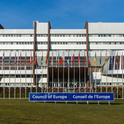Roma in Panorata, Romania: “People always make the mistake of lumping Europe’s Roma together as a single entity” © AP Photo/Vadim Ghirda, © getty images
You know the picture. Woman in a headscarf. Hand outstretched. Plaintive, somehow exotic face. An atmosphere of ill-health and dirt. A British park bench. This is the tabloid imagery that has been used more than any other to raise popular anxieties about a new flood of Eastern European migrants due to arrive this year. Not images of well-trained Romanian doctors, or polite Bulgarian baristas, migrating to plug gaps in our economy and take low-paying service jobs, but of poor, vagrant Roma, over here to beg and steal.
Part of this moral panic has been almost entirely synthetic. Newspapers such as the Daily Mail casually and repeatedly elide the idea of the Roma (an ethnic group with its largest populations in Central and Eastern Europe) and Romanians. (Confusingly the two words have nothing to do with each other). The right-wing press has also devoted a fantastic amount of attention to a small group of Romanian Roma—rarely numbering more than about 30 people—who have been sleeping rough and begging in Park Lane and Mayfair since late 2011, invoking vaguely sinister language all the while. “We can do nothing to stop the entire population of Transylvania—charming though most of them may be—from trying to pitch camp at Marble Arch,” said London’s Mayor, Boris Johnson, presumably plucking the first Romanian region that came to mind, last November.
That’s not to say there haven’t been, and aren’t, specific cases of Roma migration from mainland Europe that—much like occasional clashes with Britain’s traveller communities—are causing real local pain. Westminster Council had to put up with some Roma squatting outside the Dorchester Hotel as it housed the International Olympic Committee during London 2012, and David Blunkett, the former Home Secretary, recently warned of the potential for an “explosion” in the Page Hall neighbourhood of Sheffield, which has been overrun by some 900 Slovakian Roma families in recent years. Last year, the Metropolitan Police reported that half the begging and a third of the pickpocketing offences in London are now being committed by Romanians— with suspicions that Roma street gangs and organised crime will be over-represented in that number.
But a national emergency this is not. And neither is it plausible, particularly in the case of the Roma, to extrapolate from smaller incidents to larger trends, and to connect their movements and behaviour to recent changes in EU labour restrictions. Partly that is because statistics about the Roma are notoriously unreliable. Very often their ethnic heritage goes simply unrecorded (the Met crime statistics for example) or is otherwise under-reported by wary populations, a legacy of the Holocaust and other pogroms. The EU itself reckons Europe’s Roma population to be anywhere between six and 12m people. We simply don’t know much about them.
As for migration, most sociologists agree that the fall of communism in Eastern Europe—and the wave of discrimination and violence unleashed against the Roma in its aftermath—had a far greater influence (“push factor” is the academic term) on persuading Roma communities to head west than any subsequent tinkering with their EU treaty rights. Roma historians date what they call the “Third Great Migration”—after two similar movements in the Middle Ages and the freeing of Roma slaves in the 1860s—to 1989, rather than the accession of new states to the EU in 2004 or 2007. I spent two months interviewing Romanian Roma in London last year and travelling to Romania to see their lives there. They had an enthusiasm for coming to the UK, but nothing that would momentously change from 1st January 2014.
But just because tabloid fears about the Roma are overblown and inaccurate doesn’t mean that this shouldn’t be a significant moment. The removal of border restrictions between the UK and Romania and Bulgaria—between them home to around two million Roma—is as good an opportunity as any for Britain to finally wake up to the great, contemporary shame of Europe’s relationship with its largest ethnic minority. After a thousand years on this continent, the Roma—to an extent which profoundly questions Europe’s self-image as a liberal, caring place in the 21st century—continue to live apart, and die apart, from the rest of us. And most of us know nothing about it.
Our mutual bafflement goes back centuries. Take the English nickname, “gypsies,” given to the small bands of dark-skinned travellers who started to turn up in Britain in around 1505. Some misunderstanding, deliberate or not, created the idea that these interesting folk were Egyptians, lost on their way to Jerusalem. Any polite curiosity didn’t last long. By 1597, “Egyptians or gypsies” were defined by law as vagabonds: to be “openly whipped until his or her body be bloody.” The few that survived, along with a separate immigration of ethnic Irish travelling people, became Britain’s current Roma and traveller community.
The rest of Europe hasn’t been much more discerning. In France, the same bands, with their copper cauldrons and silver buttons, were “bohèmes”, mistaken for wandering dukes from the east. In Germany, and across much of the rest of the continent, their name was “zigeuner”, or “zingari” (Italian), “cigányok” (Hungarian)—deriving from a medieval Greek word meaning “heretics” or “untouchables.” Legends abounded. They were renegade Muslims. They were Attila’s lost Huns. They were a missing Mongol horde. Even the current, accepted term—Roma—has its problems. Most anthropologists think it comes from the Rom, or Dom, a travelling underclass of musicians in India. Others insist the name was picked up by Asian migrants as they passed through the fraying edges of the Byzantine Empire between the 10th and 12th centuries, where men still called themselves “Romanoi.”
Centuries of shifting identities, orientalism and slavery (the Roma were owned as possessions in much of Eastern Europe until 1863), have produced a people living —for the most part—marginal existences. In 2002, the United Nations Development Programme described the living conditions of the Roma in Eastern and Central Europe as “closer to those of sub-Saharan Africa than to Europe.” A decade later, a survey of Roma living conditions in 11 EU member states by the European Commission found that around 90 per cent live below national poverty lines; fewer than one in three are in paid employment; half reported suffering discrimination in the past year and 45 per cent live in households lacking either an indoor kitchen, a toilet, bathroom or electricity. Bulgarian Roma live, on average, 10 years less than the rest of the population. In Italy, the gap is 20 years. One in four Roma children in Romania make it through high school.
In a strange way, the sense of failure might be less overwhelming if nobody had been trying to do anything about it. But the opposite, of course, is true. Europe’s Roma people, its “travellers, gypsies, manouches, ashkali, sinti, etc,” as the EU calls them, have been plastered for years in assessments, communications and strategies. EU member states (all 27 of which submitted new national Roma integration strategies last year) can apply for “European structural funds” to pay for Roma inclusion projects—a total of €30bn—but only a microscopic fraction has been spent in this way. Attention to the cause remains stubbornly low, 90 per cent of the way through the EU’s “Decade of Roma Inclusion,” which began in 2005.
Which raises the question, what can be done now? David Blunkett was right last year to tell the government to stop “burying its head in the sand” about the lives of Roma people in this country. (Estimates of the population vary between 200,000 and 500,000, a combination of old and new migrations). In Europe more widely, there is a tension between treating this as a supra-national problem (sensible in an age of open borders) and a national one (ultimately change is only going to come through local education and health initiatives). More deeply, I was struck during my reporting last year by a sense of intellectual fatigue among Roma activists and government officials who have been working on these questions for a decade or more and getting nowhere. “We are sick of policies,” Damian Draghici, the Romanian Prime Minister’s advisor on Roma affairs told me. “What we need is reform in mentality and attitude. Mentality and attitude. That’s it. It’s simple. We need a brainwashing.”
And of course it cuts both ways. Nothing will change until Roma communities (a crazy quilt: there are 27 Roma groups in Romania alone) begin to dismantle their own prejudices about us, the “gadje,” and confront their cultural hang-ups around education and early marriage. Draghici, a former jazz flute player who is probably Romania’s most famous Roma, told me that he first place he ever experienced prejudice was in his own home. “My parents said: ‘Don’t behave like them...,’ ‘You’re not going to be able to like them because they are non Roma,’ ‘They are smarter than us.’ That is the biggest problem, the Roma self-discriminate.”
Florin Manoliu, another up-and-coming Roma politician in Bucharest, told me that he dreamed of something along the lines of the Haskalah, the Jewish enlightenment movement of the 18th and 19th centuries, that would encourage the Roma to maintain their ethnic identity, but take part in mainstream European society. “We need something like this for the Roma,” he said.
It won’t be easy. More than anything, in 21st century Europe, it is the sheer weight of their poverty, as much anything to do with history, that marks many Roma out, and puts them in a category of their own. It also makes them hard to help. “The poor will always want to stay together,” said Semiramida Balan, a Roma activist I met in northern Romania, “because that is their only way of being strong.” But Europe’s finally open borders mean we—and that means Britain—don’t have any choice any more. In 1993, watching pogroms and violence spark across former communist Europe, Vaclav Havel, the former Czech president, described the treatment of the Roma as “a litmus test not of democracy but of a civil society.” We failed it then. And we’re failing it now.












